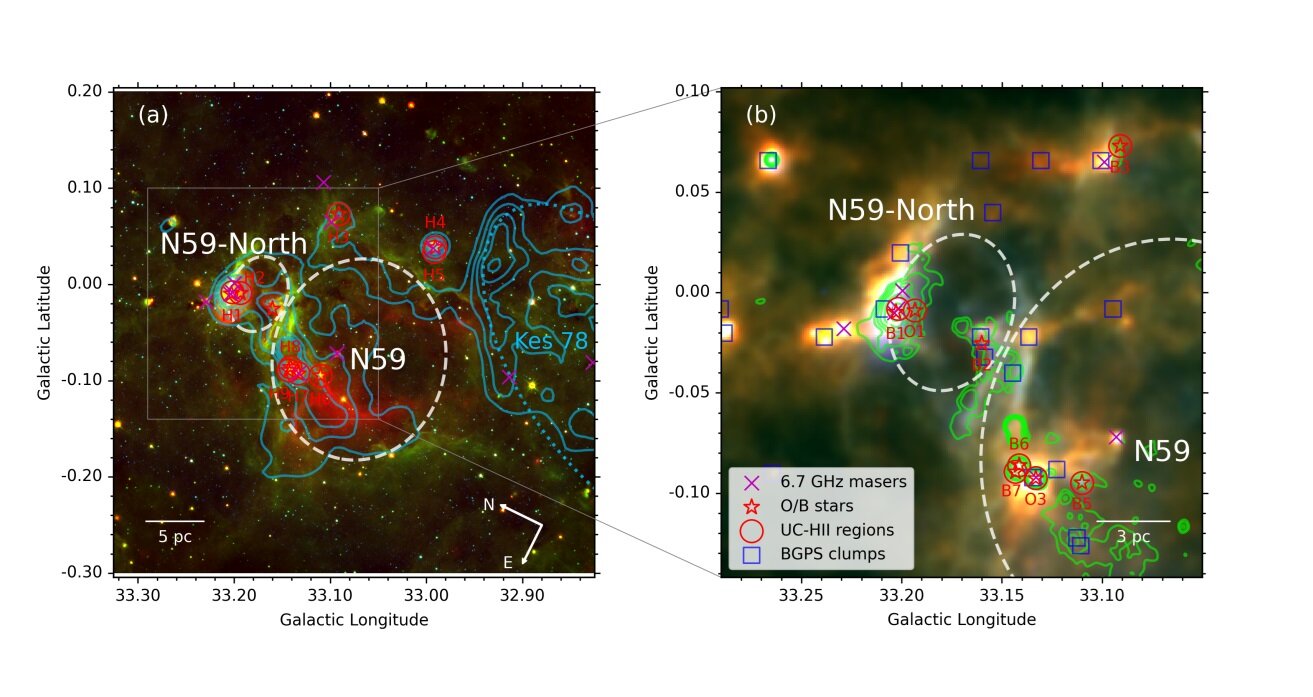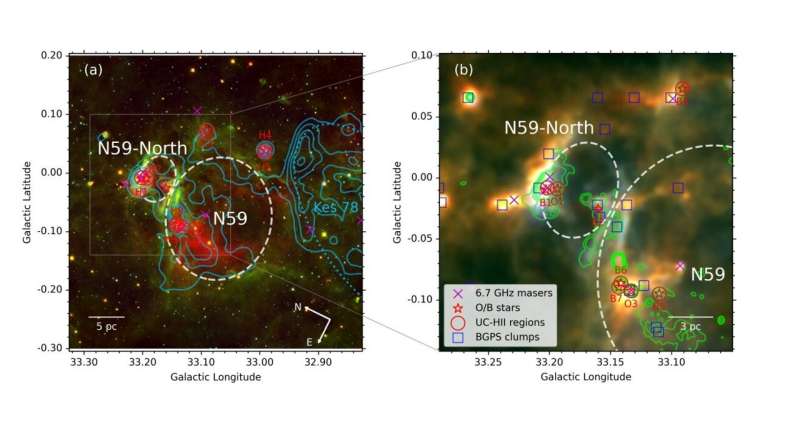

Using the Purple Mountain Observatory (PMO), Chinese astronomers have observed a mid-infrared interstellar bubble known as N59. They detected multiple cloud-cloud collisions that may be behind star formation processes in this bubble. The findings were published October 17 on the pre-print server arXiv.
In 2003, a visual inspection of images from the Galactic Legacy Infrared Mid-Plane Survey Extraordinaire (GLIMPSE) revealed the existence of a large number of full or partial ring structures. Astronomers assume that these rings are projections of three-dimensional shells and therefore refer to them as bubbles.
N59 is a mid-infrared bubble first detected in 2006. It is located in the first Galactic quadrant at a mean distance of about 15,200 light years away from the Earth. The location of N59 is close to the meeting point of the Galactic bar and spiral arm (the Scutum-Centaurus arm), where a mini-starburst region designated W43 exists.
Previous studies have found that the formation of this mini-starburst may be a result of collision of gas flows from the bar and the arm, which suggests that the similar N59 may have the same origin as W43.
In order to get more insights into the origin and properties of N59, a team of astronomers led by En Chen of the Guangzhou University in China, has employed PMO’s 13.7-m single-dish millimeter telescope to conduct observations of this bubble as part of the Milky Way Imaging Scroll Painting (MWISP) project.
The observational campaign allowed Chen’s team to decompose gas in N59 into four velocity components, which received the names Cloud A, B, C and D. They detected four cloud-cloud collision processes involving these clouds. The so-called cloud-cloud collision (CCC) processes can trigger star formation in a variety of mass ranges, from low-mass young stellar objects (YSOs) to massive OB-type stars.
“Four cloud-cloud collision processes occur involving the following velocity components: the 10 km/s collision between Cloud A and Cloud B, the 18 km/s collision between Cloud A and Cloud C, the 6 km/s collision between Cloud C and Cloud D, and the 24 km/s collision between Cloud A and Cloud D,” the researchers wrote in the paper.
The study found that Cloud B collided with Cloud A, creating a distinct U-shape cavity in Cloud A and triggered the formation of at least five YSO groups. The collision of Cloud C and A created a large U-shape cavity to the west of Cloud A and triggered the formation of at least three YSO groups and three massive stars.
Furthermore, the results suggest that Cloud C may have collided with both Cloud A and Cloud D at the same time, which together triggered the formation of one YSO group. It also turned out that the collision of Cloud A and D, produced a massive star of spectral type O9.5V, with an expanding region of ionized atomic hydrogen.
Therefore, based on the collected data, the authors of the paper suppose that the N59 bubble is an active star formation region caused by multiple cloud-cloud collisions.
More information:
En Chen et al, Multiple collisions in N59 bubble: Sequential cloud-cloud collisions, arXiv (2024). DOI: 10.48550/arxiv.2410.13742
Journal information:
arXiv
© 2024 Science X Network
Citation:
Astronomers observe cloud-cloud collisions in the interstellar bubble N59 (2024, October 23)
retrieved 23 October 2024
from https://phys.org/news/2024-10-astronomers-cloud-collisions-interstellar-n59.html
This document is subject to copyright. Apart from any fair dealing for the purpose of private study or research, no
part may be reproduced without the written permission. The content is provided for information purposes only.